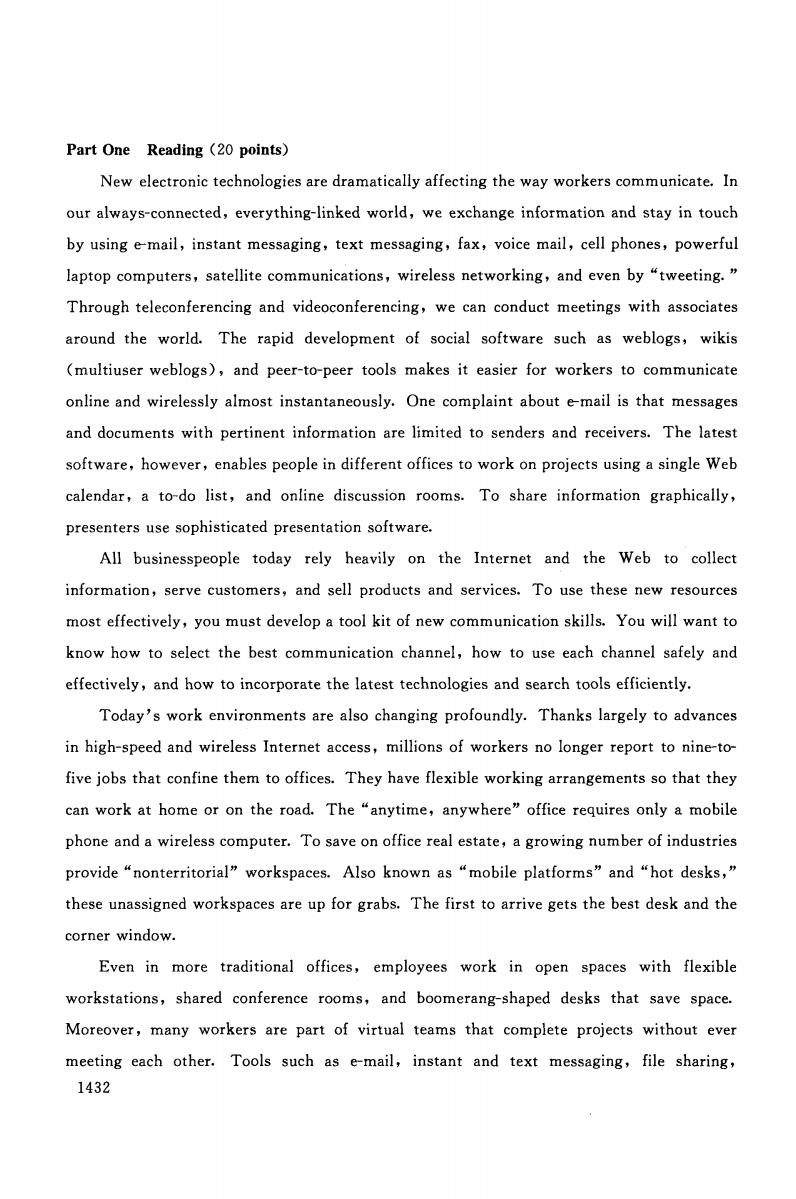正在加载图片...

Part One Reading (20 points) New electronic technologies are dramatically affecting the way workers communicate.In our always-connected,everything-linked world,we exchange information and stay in touch by using e-mail,instant messaging,text messaging,fax,voice mail,cell phones,powerful laptop computers,satellite communications,wireless networking,and even by "tweeting." Through teleconferencing and videoconferencing,we can conduct meetings with associates around the world.The rapid development of social software such as weblogs,wikis (multiuser weblogs),and peer-to-peer tools makes it easier for workers to communicate online and wirelessly almost instantaneously.One complaint about e-mail is that messages and documents with pertinent information are limited to senders and receivers.The latest software,however,enables people in different offices to work on projects using a single Web calendar,a to-do list,and online discussion rooms.To share information graphically, presenters use sophisticated presentation software. All businesspeople today rely heavily on the Internet and the Web to collect information,serve customers,and sell products and services.To use these new resources most effectively,you must develop a tool kit of new communication skills.You will want to know how to select the best communication channel,how to use each channel safely and effectively,and how to incorporate the latest technologies and search tools efficiently. Today's work environments are also changing profoundly.Thanks largely to advances in high-speed and wireless Internet access,millions of workers no longer report to nine-to- five jobs that confine them to offices.They have flexible working arrangements so that they can work at home or on the road.The "anytime,anywhere"office requires only a mobile phone and a wireless computer.To save on office real estate,a growing number of industries provide“nonterritorial”workspaces.Also known as“mobile platforms”and“hot desks,” these unassigned workspaces are up for grabs.The first to arrive gets the best desk and the corner window. Even in more traditional offices,employees work in open spaces with flexible workstations,shared conference rooms,and boomerang-shaped desks that save space. Moreover,many workers are part of virtual teams that complete projects without ever meeting each other.Tools such as e-mail,instant and text messaging,file sharing, 1432Part One Reading (20 points) New electronic technologies are dramatically affecting the way workers communicate. In our always-connected , everything-linked wor1d , we exchange information and stay in touch by using e-mail , instant messaging , text messaging , fax , voice mail , cell phones, powerful laptop computers, satellite communications, wireless networking , and even by "tweeting. " Through teleconferencing and videoconferencing , we can conduct meetings with associates around the world. The rapid development of social software such as weblogs, wikis (multiuser weblogs) , and peer-to-peer tools makes it easier for workers to communicate online and wirelessly almost instantaneously. One complaint about e-mail is that messages and documents with pertinent information are limited to senders and receivers. The latest software , however, enables people in different offices to work on projects using a single Web calendar , a to-do list , and online discussion rooms. To share information graphically , presenters use sophisticated presentation software. All businesspeople today rely heavily on the Internet and the Web to collect information , serve customers, and sell products and services. To use these new resources most effectively , you must develop a tool kit of new communication skills. You will want to know how to select the best communication channel , how to use each channel safely and effectively , and how to incorporate the latest technologi and search tools efficiently. Today' s work environments are also changing profoundly. Thanks largely to advances in high-speed and wireless Internet access, millions of workers no longer report to nine-tofive jobs that confine them to offices. They have flexible working arrangements so that they can work at home or on the road. The "anytime , anywhere" office requires only a mobile phone and a wireless computer. To save on office real estate , a growing number of industries provide "nonterritorial" workspaces. Also known as "mobile platforms" and "hot desks," these unassigned workspaces are up for grabs. The first to arrive gets the best desk and the corner window. Even in more traditional offices, employees work in open spaces with flexible workstations, shared conference rooms, and boomerang-shaped desks that save space. Moreover , many workers are part of virtual teams that complete projects without ever meeting each other. Tools such as e-mail , instant and text messaging , file sharing , 1432